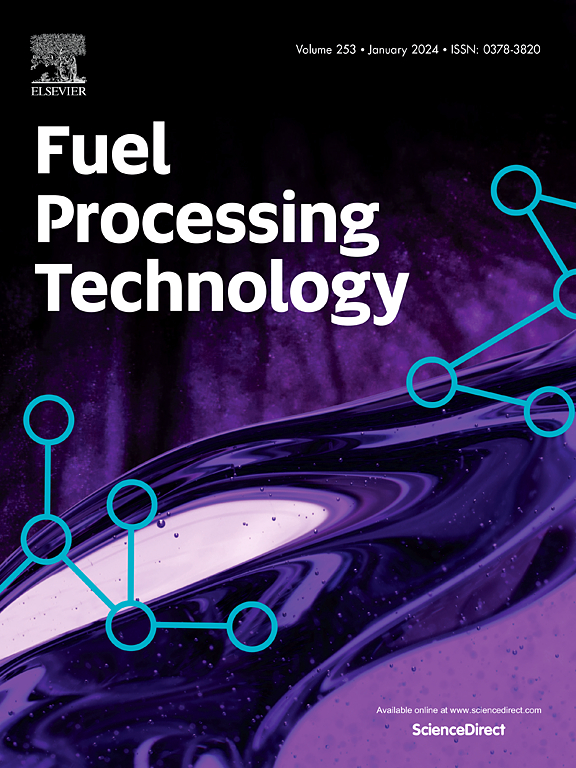Enhancing the combustion and safety performance of Al@AP Core-Shell structures with boron nitride
IF 7.7
2区 工程技术
Q1 CHEMISTRY, APPLIED
引用次数: 0
Abstract
Enhancing energy release and safety performance of energetic materials has garnered significant attention in composite solid propellants. Boron nitride (BN), known for its high thermal conductivity and lubricating properties, is a promising additive. To explore its application in propellants, Al@AP core-shell structure particles were prepared using an in situ deposition method. Structural characterisation, thermal decomposition properties, combustion characteristics, and safety of BN-doped Al@AP samples were evaluated using SEM, BET, XRD, DSC-TG-FTIR, closed bomb, laser ignition, and BAM standards. The results confirmed that AP effectively coated Al to form a typical core-shell structure, and BN was successfully incorporated into the Al@AP framework. BN promoted the thermal decomposition of Al@AP; at 0.5 wt% and 1.0 wt% BN, the low-temperature decomposition temperature of AP decreased by 28.01 °C and 26.85 °C, while the high-temperature decomposition temperature dropped by 6.41 °C and 5.25 °C, respectively. Closed bomb and laser ignition experiments indicated that with increasing BN content, the pressure rise rate and combustion intensity initially increased and then decreased. At 0.5 wt% and 1.0 wt% BN, the maximum pressure reached 127.93 kPa and 155.97 kPa, with corresponding pressure rise rates of 19.12 kPa/ms and 11.80 kPa/ms. The addition of BN significantly improves the safety performance of Al@AP, considerably reducing its impact and friction sensitivities. These findings demonstrated that when the BN content was 0.5 wt% and 1.0 wt%, both the combustion characteristics and safety of Al@AP were improved, achieving a practical balance and providing design guidance for the application of BN-doped Al@AP in solid propellants.

氮化硼增强Al@AP核壳结构的燃烧和安全性能
提高含能材料的能量释放和安全性能已成为复合固体推进剂研究的热点。氮化硼(BN)以其高导热性和润滑性而闻名,是一种很有前途的添加剂。为了探索其在推进剂中的应用,采用原位沉积法制备了Al@AP核壳结构颗粒。采用SEM、BET、XRD、DSC-TG-FTIR、封闭弹、激光点火和BAM标准对bn掺杂Al@AP样品的结构表征、热分解性能、燃烧特性和安全性进行了评价。结果证实,AP有效地包覆Al,形成典型的核壳结构,BN成功地纳入Al@AP框架。BN促进了Al@AP的热分解;在0.5 wt% BN和1.0 wt% BN下,AP的低温分解温度分别下降28.01℃和26.85℃,高温分解温度分别下降6.41℃和5.25℃。封闭弹和激光点火实验表明,随着BN含量的增加,压升速率和燃烧强度先增大后减小。在0.5 wt%和1.0 wt% BN条件下,最大压力分别达到127.93 kPa和155.97 kPa,压力上升速率分别为19.12 kPa/ms和11.80 kPa/ms。BN的加入显著提高了Al@AP的安全性能,显著降低了其冲击和摩擦敏感性。这些结果表明,当BN含量为0.5 wt%和1.0 wt%时,Al@AP的燃烧特性和安全性都得到了改善,达到了实际的平衡,为BN掺杂Al@AP在固体推进剂中的应用提供了设计指导。
本文章由计算机程序翻译,如有差异,请以英文原文为准。
求助全文
约1分钟内获得全文
求助全文
来源期刊

Fuel Processing Technology
工程技术-工程:化工
CiteScore
13.20
自引率
9.30%
发文量
398
审稿时长
26 days
期刊介绍:
Fuel Processing Technology (FPT) deals with the scientific and technological aspects of converting fossil and renewable resources to clean fuels, value-added chemicals, fuel-related advanced carbon materials and by-products. In addition to the traditional non-nuclear fossil fuels, biomass and wastes, papers on the integration of renewables such as solar and wind energy and energy storage into the fuel processing processes, as well as papers on the production and conversion of non-carbon-containing fuels such as hydrogen and ammonia, are also welcome. While chemical conversion is emphasized, papers on advanced physical conversion processes are also considered for publication in FPT. Papers on the fundamental aspects of fuel structure and properties will also be considered.
 求助内容:
求助内容: 应助结果提醒方式:
应助结果提醒方式:


